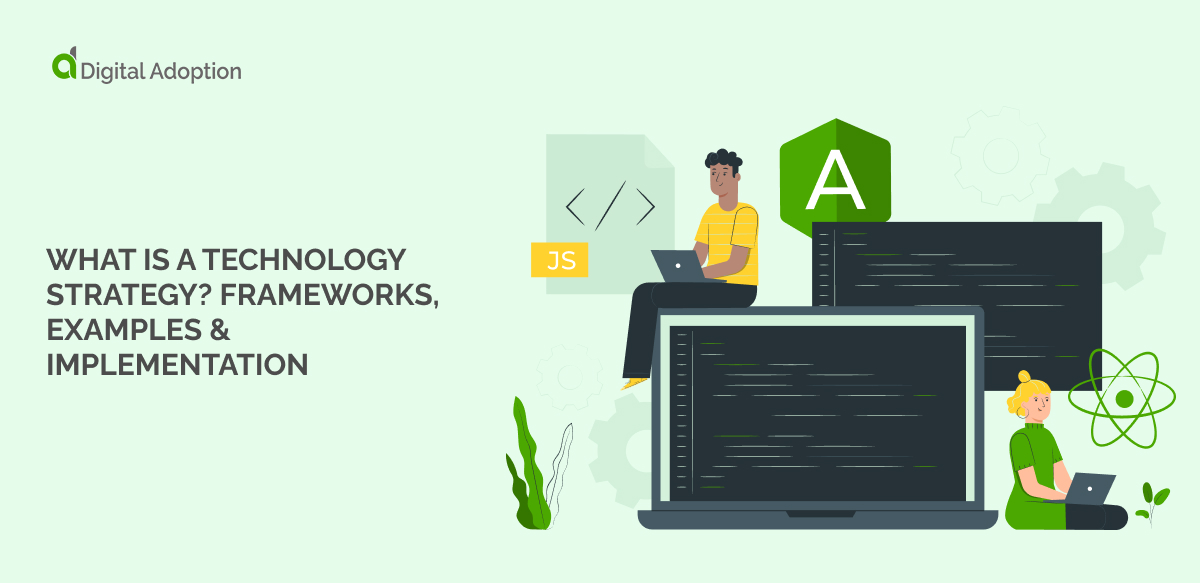In an era defined by digital transformation, a technology strategy enables cross-functional solutions for aligning existing business strategies with technology. It identifies the necessary technological capabilities that support business initiatives in facilitating growth and operational resilience.
A comprehensive tech strategy is essential to any future-ready IT strategy, providing a fundamental framework that guides technology’s role in supporting the business.
Research from Statista shows that many executives recognize technology investments as a valuable competitive advantage and want to reshape their entire business strategies around digital technologies.
Adopting an appropriate technology framework allows businesses to standardize decision-making, highlight areas of improvement, prioritize tech investments, and streamline system upgrades.
In this article, we will define a technology strategy and explore some common technology frameworks businesses use, including examples of how they have been implemented successfully.
What Is A Technology Strategy?
A technology strategy is a detailed plan outlining how an organization will utilize technology to fulfill its goals and targets.
The strategy supplements an organization’s overarching IT strategy and comprises key tenets, objectives, and methods related to the role of technology in business advancement.
This involves determining technology’s prospective application within business environments, including identifying pain points and formulating a roadmap for implementing chosen technologies.
According to the IDC’s Worldwide Digital Transformation Spending Guide, global DX spending will reach $3.4 trillion in 2026, with a CAGR of 16.3% over the next five years.
The scope of a technology strategy transitions from broad to specific, with detailed strategies evolving from broader business ambitions.
In the process, the technology strategy identifies the required capabilities to achieve these objectives based on the analysis of tangible business scenarios.
Establishing a clear tech strategy is an essential prerequisite for any forward-thinking business, enabling them to leverage the benefits of technology in the most optimal way.
Why Is A Technology Strategy Important?
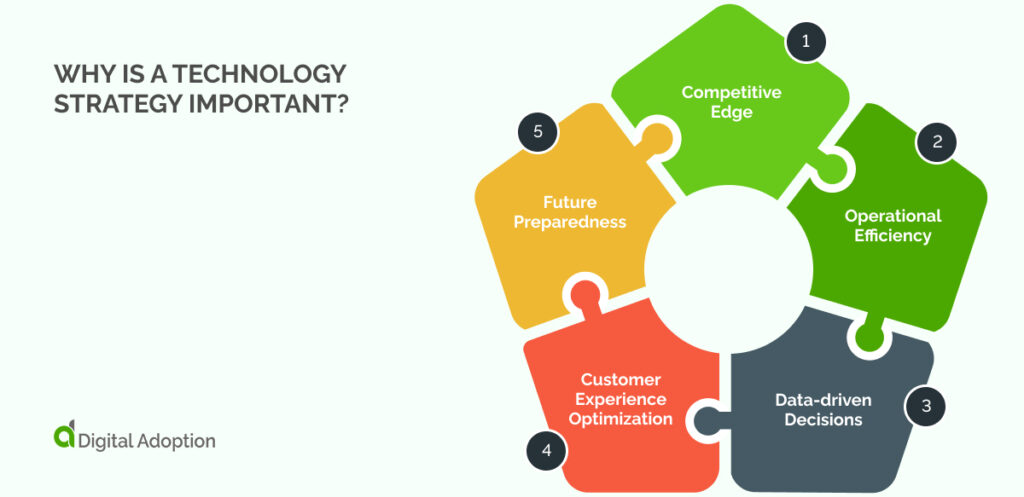
According to McKinsey, technology strategies have proven invaluable in helping organizations understand the scale of necessary change and think through interdependencies across various aspects.
Leveraging a strategic technology approach allows businesses to carve out a unique market position, streamline operations, manage risks robustly, utilize data effectively, enhance customer engagement, and prepare for future technological advancements.
Let’s take a closer look at why establishing a technology strategy is so important and some of the benefits that can be realized in doing so:
Competitive Edge
Through the strategic and thoughtful implementation of cutting-edge technologies, businesses can optimize their operations, increasing efficiency and productivity.
This, in turn, paves the way for the enhancement of product or service quality, enabling organizations to better meet the shifting needs and expectations of their customers.
An innovative approach such as this empowers companies to secure market dominance and a competitive advantage in the high-octane commercial world.
Operational Efficiency
Implementing a well-defined technology strategy enables efficient automation of routine tasks and seamless integration of various systems.
This integration leads to the streamlining of processes, resulting in heightened productivity and cost reduction.
With the elimination of manual efforts and the optimization of technological capabilities, organizations can improve operations resource allocation and bolster overall performance.
Data-driven Decisions
A well-defined technology strategy not only provides a clear roadmap for technology investments but also facilitates informed decision-making that parallels the strategic objectives of the organization.
By establishing a comprehensive plan that considers the evolving technological landscape and the specific needs of the business, a strategy enables effective asset allocation and maximizes return on investment (ROI).
It also helps identify emerging technologies, assess their potential impact, and ensure that technology initiatives are in line with the long-term vision of the organization.
Customer Experience Optimization
Cutting-edge technology tools such as AI and data analytics, when strategically applied, have the remarkable ability to enhance customer interactions in countless ways.
Leveraging the power of AI allows businesses to uncover valuable insights into customer preferences and behaviors.
This knowledge enables them to craft personalized experiences that boost satisfaction and cultivate enduring loyalty.
Future Preparedness
Staying current with the latest emerging technology trends and proactively structuring their integration with a well-crafted technology strategy primes businesses for a future-ready state.
This approach allows them not only to remain adaptable and relevant but also to seize new opportunities. With a keen focus on innovation, holistic learning, and proactive planning, organizations can position themselves as true digital transformation leaders.
What Is A Technology Strategy Framework?
A technology strategy framework plots the actionable approach a company will take to leverage technology in achieving its objectives.
The framework provides a concrete roadmap for the acquisition, utilization, and management of technology resources, including hardware, software, and human capital.
The strategy often involves identifying key technology trends relevant to the business, establishing technology-related goals, and crafting action plans to meet these goals. This includes evaluating current technology infrastructure, identifying gaps and pain points, and determining the solutions to remedy them.
Different frameworks emphasize different aspects, such as IT governance, data management, cybersecurity, or digital transformation.
For instance, the Technology Business Management (TBM) discipline guides organizations in managing and communicating the cost, value, and quality of IT services in a business context.
A well-defined technology strategy framework ensures technology investments remain aligned with business goals and delivers maximum value.
Technology Strategy Examples
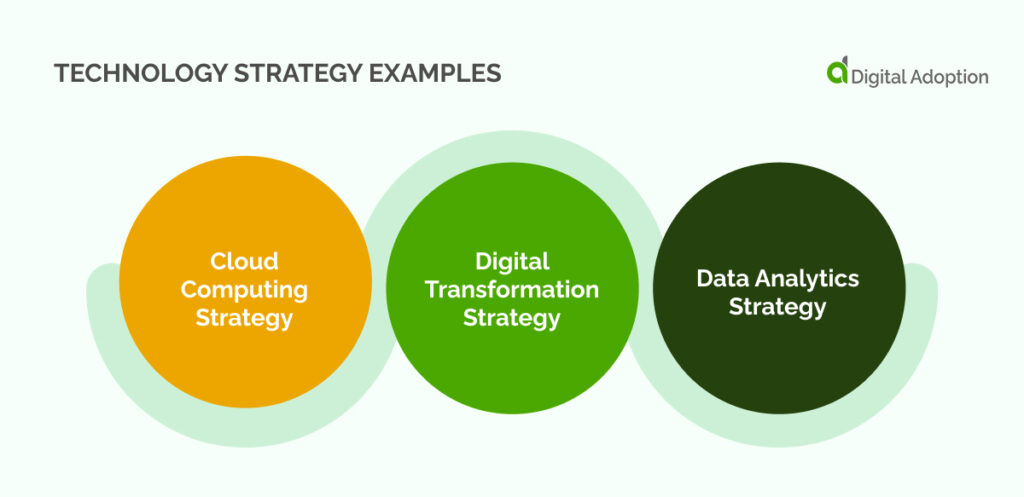
Cloud Computing, Digital Transformation, and Data Analytics strategies characterize three of the top strategic approaches to technology that many leading organizations are currently pursuing
Let’s take a closer look at these areas of interest:
Cloud Computing Strategy
A cloud computing strategy enables organizations to operate on scalable, flexible cloud-based platforms. It involves moving data storage, processing, and management from on-premise servers to the cloud.
This strategy helps save on infrastructure costs, as companies only pay for the resources they use and can scale up or down based on demand. It also enhances accessibility, as employees can access data and applications from anywhere, anytime, improving collaboration and efficiency.
Depending on the organization’s requirements, they can opt for public clouds for cost-effectiveness, private clouds for enhanced security, or hybrid clouds for both.
Digital Transformation Strategy
A digital transformation strategy completely overhauls business operations by integrating digital technology.
It’s not just about updating systems; it’s about fostering a culture that embraces change, innovation, and continuous learning.
In this regard, a DX strategy provides businesses with a vehicle for capturing the benefits of technology, delivering superior customer experiences, and creating bleeding-edge products and services.
It also improves operational efficiency by automating processes, enhancing data management, and facilitating real-time communication. However, successful digital transformation requires strong leadership, clear vision, and employee engagement.
As shown by McKinsey research—when organizations undertake a large-scale transformation, their efforts fail about 70 percent of the time.
Data Analytics Strategy
A data analytics strategy leverages advanced technologies to convert raw data into actionable insights.
Businesses can analyze vast amounts of data quickly and accurately by harnessing Big Data, Machine Learning (ML), and artificial intelligence (AI). This strategy enables businesses to forecast trends, optimize operations, and better tailor products or services.
For instance, predictive analytics can forecast customer behavior, while prescriptive analytics can suggest actions to achieve business goals.
However, a successful data analytics strategy requires quality data, skilled analytics officers, and a culture that sees the value of data-driven decision-making.
Technology Strategy Framework Essentials
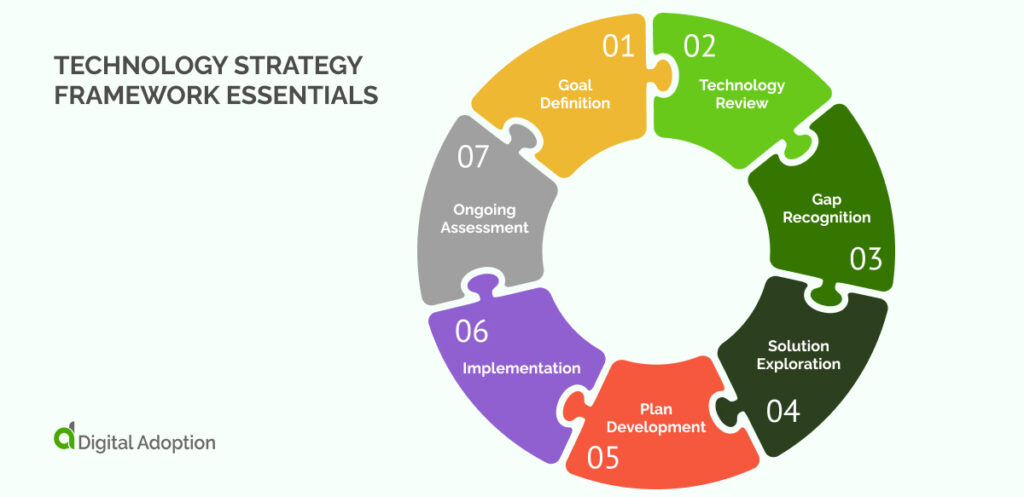
Developing and implementing a technology strategy involves steps crucial for aligning technology with an organization’s strategic objectives.
To fully understand the mechanics, let’s take a look at key touch-points essential to a technology strategy framework:
- Goal Definition: An organization must explicitly outline strategic objectives and the role of technology in facilitating these objectives. Goals could encompass enhancing operational performance, boosting customer service quality, or reimagining products or services.
- Technology Review: Investigate the existing technology environment within the organization and the larger industry. This entails cataloging current technology resources, evaluating their efficiency, and exploring emerging technologies that could provide a competitive edge.
- Gap Recognition: Pinpoint any discrepancies between the organization’s existing technology capabilities and the requirements necessary to meet strategic goals. These gaps could be present in hardware, software, data management, security measures, and skill sets, among other areas.
- Solution Exploration: Recognize potential remedies to address the identified deficiencies. Solutions could involve acquiring new technology, upgrading current systems, outsourcing, and cultivating new organizational competencies, among other initiatives.
- Plan Development: Devise a comprehensive plan for deploying the identified solutions. The plan should encompass a timeline, necessary resources, responsibilities, and crucial performance metrics (KPIs) to track progress.
- Implementation: Execute the devised plan, track advancement against the KPIs, and modify the plan based on feedback and evolving circumstances.
- Ongoing Assessment: Regularly scrutinize and assess the technology strategy to verify its effective alignment with the organization’s strategic goals. Modify the strategy in response to evolving business requirements, technological advancements, and insights gained from implementation.
What’s Next For Technology Strategies?
As we look ahead, the potentially infinite potential of evolving technology calls for the constant introduction and reshaping of tech strategies for delivering value in both business and wider social zeitgeists.
IT leaders and CIOs can anticipate a landscape dominated by an accelerated pace of innovation, where agility and adaptability become essential survival skills for those companies chasing state-of-the-art status.
Artificial intelligence and machine learning will continue to evolve, offering organizations unprecedented capabilities to analyze data, automate processes, and improve decision-making.
The adoption of cloud technologies will continue to surge, providing organizations with greater flexibility, scalability, and cost efficiencies. This will be complemented by the rise of edge computing, bringing computation and data storage closer to where it’s needed, improving response times, and saving bandwidth.
Cybersecurity, too, will take center stage, with solutions becoming more nuanced and complex as increasing digitization and connectivity raise new challenges and threats.
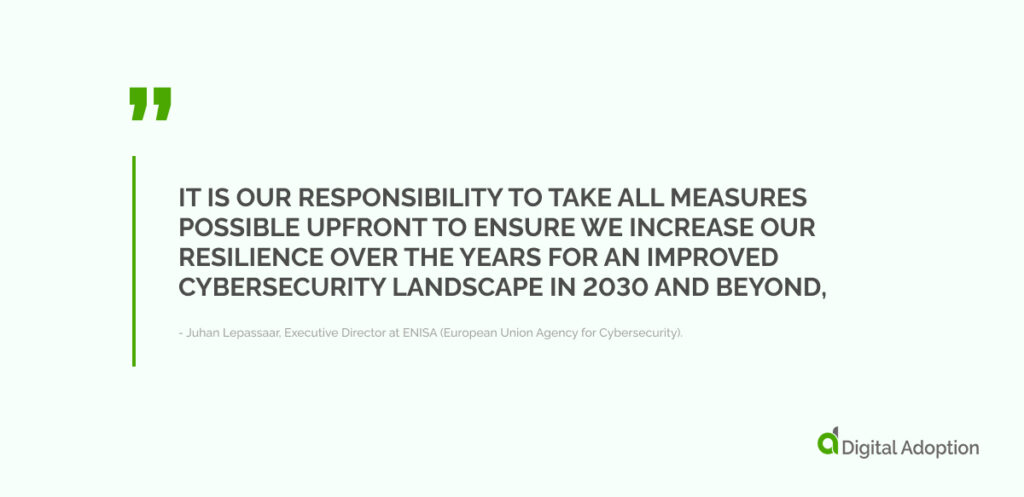
“It is our responsibility to take all measures possible upfront to ensure we increase our resilience over the years for an improved cybersecurity landscape in 2030 and beyond,” says Juhan Lepassaar, Executive Director at ENISA (European Union Agency for Cybersecurity).
The role of IT leaders and CIOs is set to become more strategic. They’ll be expected not just to manage technology but to drive business value, foster innovation, and continually transform.
The emphasis will shift from merely keeping the lights on to using technology as a competitive differentiator and a catalyst for growth.
Ultimately, the future of technology strategies will be shaped by those who can blend technical acumen with business savviness and understand that at the heart of every tech strategy lies the goal of creating value for the organization, customers, and stakeholders.

